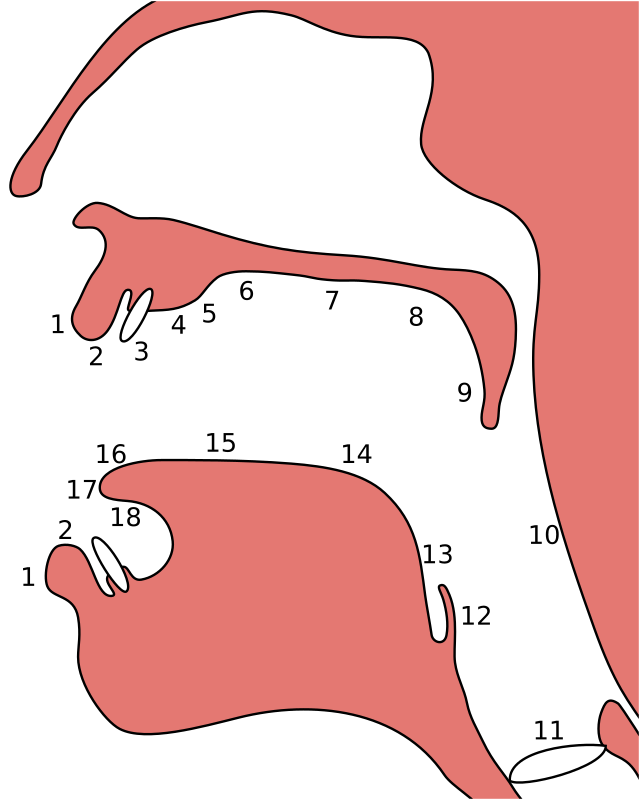The epiglottal or pharyngeal plosive (or stop) is a type of consonantal sound, used in some spoken languages. The symbol in the International Phonetic Alphabet that represents this sound is ⟨ʡ⟩.
| Epiglottal plosive (pharyngeal plosive) | |||
|---|---|---|---|
| ʡ | |||
| IPA Number | 173 | ||
| Audio sample | |||
| Encoding | |||
| Entity (decimal) | ʡ | ||
| Unicode (hex) | U+02A1 | ||
| X-SAMPA | >\ | ||
| Braille | |||
| |||
Epiglottal and pharyngeal consonants occur at the same place of articulation. Esling (2010) describes the sound covered by the term "epiglottal plosive" as an "active closure by the aryepiglottic pharyngeal stricture mechanism" – that is, a stop produced by the aryepiglottic folds within the pharynx.[1]
Features

Features of the epiglottal stop:
- Its manner of articulation is occlusive, which means it is produced by obstructing airflow in the vocal tract. Since the consonant is also oral, with no nasal outlet, the airflow is blocked entirely, and the consonant is a plosive.
- Its place of articulation is epiglottal, which means it is articulated with the aryepiglottic folds against the epiglottis.
- It has no defined phonation, although it is typically voiceless, which means it is produced without vibrations of the vocal cords. Voiced epiglottal "stops" tend toward being epiglottal flaps.[citation needed]
- It is an oral consonant, which means air is allowed to escape through the mouth only.
- It is a central consonant, which means it is produced by directing the airstream along the center of the tongue, rather than to the sides.
- Its airstream mechanism is pulmonic, which means it is articulated by pushing air solely with the intercostal muscles and abdominal muscles, as in most sounds.
Occurrence
| Language | Word | IPA | Meaning | Notes | |
|---|---|---|---|---|---|
| Amis | 'u'ul | [ʡuʡuɺ̠ᵊ] | 'fog' | May have a trilled release, [ʡʢ]. | |
| Archi[2] | гӀарз/g'arz | [ʡarz] | 'complaint' | ||
| Dahalo[3] | 'lake' | ||||
| Haida | Northern dialects | g̱antl | [ʡʌntɬ] | 'water' | Corresponds to /q/ in southern dialects. |
| Ingush[4] | Ӏам/wam | [ʡam] | 'lake, pond' | Also represented with "Ӏ" in the Cyrillic orthography. | |
See also
Notes
References
External links
Wikiwand in your browser!
Seamless Wikipedia browsing. On steroids.
Every time you click a link to Wikipedia, Wiktionary or Wikiquote in your browser's search results, it will show the modern Wikiwand interface.
Wikiwand extension is a five stars, simple, with minimum permission required to keep your browsing private, safe and transparent.


